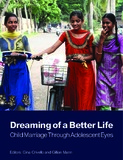Early Marriage among Adolescent Boys and Young Men in Urban Informal Settlements of Bangladesh
Citation
Biswas, S., Azmi, R., Mowri, S., Ahsan, S., Sultana, R., & Rashid, S. F. (2020). Study: Sexual harassment common among young women workers in Bangladesh: Social and gender norms constrain women in articulating transgressive and inappropriate behaviour by men. In G. Crivello & G. Mann (Eds.), Dreaming of a better life: Child marriage through adolescent eyes (pp. 95–105). Oxford, UK: Young Lives. https://www.younglives.org.uk/sites/www.younglives.org.uk/files/YL-DreamingOfBetterLife-LowRes_0.pdfAbstract
Early marriage continues to be a major public health concern and a violation of child rights,
particularly in developing countries.1
Girls are disproportionately more likely to marry before
the age of 18 compared to boys, and the vast majority of research, policy and advocacy on
child marriage relates specifically to girls (Parsons et al. 2015; Patton et al. 2016; Svanemyr
et al. 2015; Wodon et al. 2017). However, adolescent boys also marry early.2
Although the
prevalence of child marriage among boys and young males is lower than girls, in recent
times, the global prevalence of early marriages among adolescent boys has gained some
prominence. An analysis by the United Nation’s Children Fund (UNICEF) reported that 115
million boys and men were married before the age of 18 (with one in five before age 15)
(Gastón, Misunas, and Cappa 2019). However, in South Asia this rate is around 5% (Malhotra
et al. 2011; Verma, Sinha, and Khanna 2013). The Bangladesh Demographic Health Survey
2011 reported that nationally around 4% of men aged 20-24 were married by age 18 (National
Institute of Population Research and Training, Mitra and Associates, and ICF International
2013). However, boys residing in poor, urban informal settlements are more likely to marry
early compared to the national average, with a study of informal settlements in Dhaka finding
that around 46% of males were married before age 18 (Khan 2014).
Although the risks and consequences of early marriage differ for boys and girls on account
of biological and social differences, the practice is nonetheless a human rights violation for
children of both sexes. Similar to child brides, when boys marry early they also face many
potentially negative health and economic consequences which threaten their well-being
(Greene et al. 2015; Misunas, Gastón, and Cappa 2019). Adolescent boys who marry early
experience an abrupt transition to adulthood with pressure to drop out of school and to
assume new household financial responsibilities. This potentially impacts their job prospects,
owing to being deprived of skills that continued education would have allowed (Gastón,
Misunas, and Cappa 2019). Being young, they are often psychologically and socially
unprepared to take on the responsibilities that come with marriage and fatherhood (Matlakala,
Makhubele, and Mashilo 2018).
In spite of this, the vulnerabilities of adolescent boys in early marriages remain largely ignored
in the development agenda, which puts more emphasis on the vulnerabilities experienced by
girls and women due to the disadvantages the latter face with respect to gender inequality
(The Lancet 2015). Boys’ and young men’s experiences and perspectives remain significantly
less researched and overwhelmingly neglected by social interventions, policy and advocacy
programmes (Greene et al. 2015).
1 ‘Early marriage’ is defined as any marriage or union between two people where one or both partners is
under the age of 18 (UNICEF 2005). However, the Child Marriage Restraint Act 2017 sets the minimum age
of 21 years for males and 18 for females for marriage in Bangladesh (Government of Bangladesh 2017).
2 We prefer to use ‘early marriage’ instead of ‘child marriage’ as ‘child marriage’ is heavily associated with
girl’s marriage in the Bangladeshi context. When a boy gets married before their legal age of 21 years,
this is considered as an ‘early marriage’ rather than ‘child marriage’.

